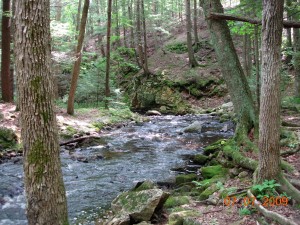
Swift River at Bear's Den Reservation, New Salem MA, a preserve of The Trustees of Reservations, the first land trust. Photo by Richard Brewer.
In the earlier version of my website, I had a page where I posted reviews of Conservancy: The Land Trust Movement In America, or links to them. The last count was a dozen. Posted here for the sake of completeness is the last one, as far as I know. It appeared in 2006, by which time I was not spending a lot of time on the old version of the website.
CONSERVANCY: The Land Trust Movement in America. By Richard Brewer. Lebanon, NH: University Press of New England. 2003
Reviewed by Donna Luckey, University of Kansas
Published in American Studies 2006, 47 (3-4): 244-245
[p. 244] Richard Brewer has given us a thorough review of land preservation and conservancy history in the United States. He provides a comprehensive treatment of land trusts, focused specifically on those trusts with the “intent to preserve land” as their stated mission. There are three main sections: the early chapters cover background for land preservation, the middle section serves as an excellent handbook for those involved with land trusts, and additional chapters provide case studies of major conservancies and local land trusts in this country.
Beginning with strong arguments for preserving biodiversity, Brewer provides species-specific examples, like the role of Running Buffalo Clover relative to ecological communities and ecosystem succession. He clarifies the differences between early advocacy groups and land preservation groups, explaining how that distinction has carried into the present. A key point is the growth of conservancies since 1980s, cited by Brewer as the true beginning of the land trust movement in America. He explains this well, illustrating the connections to environmental awareness, changes in the federal government’s policies, and other aspects of that era.
The middle section, chapters 3-8, is very useful for landowners, land trust staff, and board members. It addresses questions of land protection: why, who, which lands, how, and what is “land stewardship”? Brewer builds directly on the earlier material, grounded in his extensive background and experience as a biologist and land trust board member. It is here that he answers explicit questions, including how to distinguish forms of land protection. For example, there is a very good section (114ff.) clarifying the actual costs of protecting land, and how to estimate them. Brewer describes the complexities of Conservation Easements, currently very popular (as verified through statistics from the Land Trust Alliance [LTA] workshops, journal articles, etc.). He examines landowner benefits for those who protect land using Conservation Easements, while also raising the “non-economic” values that motivate landowners. He emphasizes ongoing stewardship as most vital; this is key among emerging issues of the conservancy movement today. Education of future generations of land-
[p. 245] owners with property protected by Conservation Easements is also raised as critical. These examples and detail, educating the public as well as current and potential land trust board members, is the gift of Brewer’s work. More images and graphics would nicely enhance this powerful text. On p. 11 Brewer describes the powerful impact four Wisconsin maps compiled by Curtis in 1956 had on him; his own readers would similarly benefit.
Additional acknowledgement of some early key players might be appropriate. These include Ralph Borsodi (father of “trustery” and the International Independence Institute) and Robert Swann. In 1972 the latter, with others, wrote The Community Land Trust – A Guide To A New Model For Land Tenure In America. The Community Land Trust (CLT) movement is indebted to these pioneers, and Brewer explains on p. 11 that CLTs focus on low-income housing. The common roots however are significant. The California State Coastal Conservancy (CCC) also provided timely and significant assistance to California land trusts forming during the critical years Brewer describes. The Humboldt North Coast Land Trust is but one example (cited by Brewer in the chapter on TPL, [222-223]) of a coastal land trust receiving CCC assistance, including financial, political, and organizational instruction.
The Lincoln Institute of Land Policy, referenced by Kingsbury Browne on p. 35 for funding his 1977 report “Case Studies in Land Preservation,” continues to contribute to this field. Jeff Pidot’s timely paper, “Reinventing Conservation Easements: A Critical Examination and Ideas for Reform,” is from the Lincoln Institute (2005). Like the CCC, the Lincoln Institute has many programs, yet each organization has played important roles for many land trusts throughout the country.
Overall, Brewer’s history is thorough and the cases detailed and well documented. He provides a good range of different types of preservation organizations and their structures, with lessons from both success and failure through many examples. This book serves the land trust movement well in each realm–as a history, as a handbook, and for general education. He is right on target with current issues in the final chapter: stewardship, public perceptions and education, and organizational relationships. Brewer gives us hope for the future of land preservation in the USA.